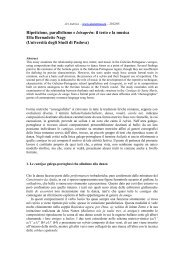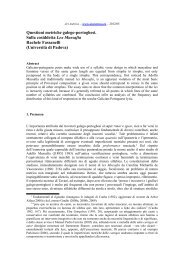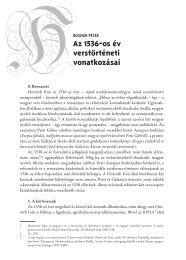The Metrical Structure of Kashmiri Vanɨvun Sadaf ... - Ars Metrica
The Metrical Structure of Kashmiri Vanɨvun Sadaf ... - Ars Metrica
The Metrical Structure of Kashmiri Vanɨvun Sadaf ... - Ars Metrica
Create successful ePaper yourself
Turn your PDF publications into a flip-book with our unique Google optimized e-Paper software.
27 Some examples in this section also involve metrical vowel insertion. For instance, insertion <strong>of</strong> the vowel ɨ in<br />
yəzɨman. This change is consistent with the historical developments in <strong>Kashmiri</strong> phonology and syllable structure,<br />
which underwent vowel epenthesis to break certain medial clusters. Such epenthetic vowels are <strong>of</strong>ten deleted in<br />
unstressed positions in the spoken language (See Munshi 2001 and Munshi & Crowhurst 2011).<br />
28 Notice the change in vowel quality from a to ə in vɨzməəlah which could be motivated by rhyme (with<br />
bismeelah)<br />
29 Note that, although not shown here, the final –uy in vańɨvunùy is itself a result <strong>of</strong> poetic repair through the addition <strong>of</strong><br />
a morphophonemic ending – a topic discussed later.<br />
30 Recall that Foot#4 <strong>of</strong> Line 1 is usually bisyllabic.<br />
31 An explanation for the change ə: > a: (in ə́:y > a:y(e:)) is that historically ə: resulted from a: when a high front vowel<br />
followed. This historical form is claimed to have been resurrected in poetry.<br />
32 This is an excerpt from a <strong>Kashmiri</strong> Hindu wedding song.<br />
33 Final aspiration in [róp h ] is the result <strong>of</strong> a historical change because <strong>of</strong> which (some) voiceless stops are aspirated in<br />
word-final position. Addition <strong>of</strong> a vowel in the poetic form removes final aspiration.<br />
34 Note that /a/ surfaces as [ɨ] in unstressed positions in <strong>Kashmiri</strong>.<br />
35 First stanza <strong>of</strong> a very popular <strong>Vanɨvun</strong> sung at the groom’s reception by his in-laws (Also sung using a non-traditional<br />
melody, in which case it is no longer <strong>Vanɨvun</strong>).<br />
36 First couplet from a <strong>Vanɨvun</strong> sung at poh – a ceremony after a newly wedded woman gives birth to her first child.<br />
37 That these clitics are morphophonemic and not simply meaningless phonological endings is illustrated in the<br />
following example where mismatch <strong>of</strong> MPs leads to ungrammaticality (as designated by an asterisk “*”):<br />
šo:xɨ ča:ni va:yey čangɨ nay sa:z-o: wish.Obl<br />
your play.2Ben.Dat Chung flute music-MP.m.sg<br />
a:k h -o /*a: k h -ay/*a:yk h - ay šahar-e:-ši:ra:z-o:<br />
came.m.sg-MP.m.sg./*came.f-MP.f.sg/*came.f-MP.f.sg city-<strong>of</strong>-Shiraz-MP.m.sg<br />
‘For (my) wish for you, I will play Chung (a musical instrument), flute and music<br />
You have come from the city <strong>of</strong> Shiraz’<br />
Thus, although *|a:k h -ay šahare:- ši:ra:z-o:| and *|a:yk h -ay šahare:- ši:ra:z-o:| are metrically perfect, both are<br />
ungrammatical because a:k h - ‘came.m.sg’ does not agree with –ay ‘MP.f.sg’, and a:yk h -ay ‘came.f-MP.f.sg’ does not<br />
agree with ši:ra:z-o: ‘Shiraz-MP.m.sg’.<br />
38 See Kiparsky (1968) for the metrical structure <strong>of</strong> the Finnish epic Kalevala, where the metrical system is determined<br />
at the morphophonemic level, permitting various apparent irregularities at the phonetic level. Also see Kiparsky (1972)<br />
for the metrics and morphophonemics <strong>of</strong> the Rigveda.<br />
39 <strong>The</strong> same is true <strong>of</strong> non-poetic kànyà:yi and pə́:rà:vni versus poetic kanya:ye: and pə:ra:vne: in the following line <strong>of</strong><br />
the same verse:<br />
[ná:gɨ-kànyà:yi pə́:rà:vni ]<br />
|na:.gɨ.-kan|ya:.a.ye: |pə:.ə.ra:v|ne: ||<br />
where the historical change <strong>of</strong> final vowel reduction is undone and the original vowel is resurrected in the<br />
poetic form. Note that the central vowel ə: in ə́:y (from a:) had resulted from a historical vowel harmony change<br />
induced by a following high front vowel which was then deleted in word-final position. <strong>The</strong> change involved was ə: ><br />
a:/_e: (i.e., a:ye: > ə:y ). See Munshi (2001) for a detailed account <strong>of</strong> diachronic vowel changes in <strong>Kashmiri</strong>.<br />
40 A similar example in English could be from Blake’s <strong>The</strong> Tyger in the two most salient lines:<br />
Did he smile his work to see?<br />
Did he who made the Lamb make thee?<br />
Note that in the first line, “did” is an ictus, while in the second, it’s an upbeat.<br />
41 A similar example <strong>of</strong> such changes is that <strong>of</strong> the meter in Urdu ghazal where differences in pronunciation (and,<br />
therefore, stress placement) may be found on the basis <strong>of</strong> poetic and non-poetic (“natural”) instances <strong>of</strong> a word. For<br />
example, a word like me:re: ‘mine. Oblique’ may be scanned as [me:re:] or [mere:] based on metrical requirements.<br />
42 Initial clusters are treated as single consonants.<br />
43 Note that this phrase extends over two metrical feet. <strong>The</strong> metrical foot under consideration is the one on the left. <strong>The</strong><br />
foot on the right side is a disyllabic final foot <strong>of</strong> an odd line in which case /u/ has undergone lengthening as well as<br />
change in quality to o: (for metrical purposes and for rhyme) .







